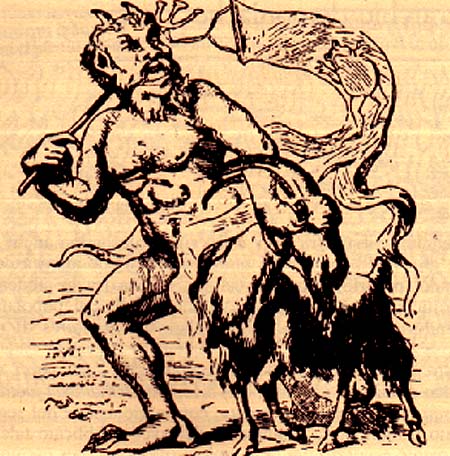 |
| Azazel from Colin de Plancy's |
| Dictionnaire Infernal (1825). |
As a young man in sixteenth-century Cremona, Italy, Clemente belongs to a cult headed by a "magician" named Alberto Fortuno. Fortuno and his followers worship Azazel*, "one of the great elder gods." According to Fortuno, the "False One" has imprisoned Azazel and it is their duty to set him free. During a ceremony replete with chanting, incense, and animal sacrifice, Fortuno drinks blood from a sacrificial goat and then, blindfolded in a darkened chamber, he draws the plans for a "device capable of opening doors to the unseen world," an act Clemente describes as the counterpart to the revelation of the plans for the Ark of the Covenant. When the drawing is complete, Furtuno announces:
“Brothers! See now! We will build an instrument that shall resonate through out the heavens. As the False One brought His creation into being with a single spoken sentence, we shall become its master’s with a single played song. It speaks with the voice of a human and will clear the way for our Lord Azazel. We are to call it—the violin.”
Fortuno chooses Clemente and Marcus Vicente--the nephew of the carpenter Guiseppe Amati--to build the violin. When complete, Fortuno organizes a ceremony on a hilltop outside Cremona to "baptize" the new instrument with the blood of "corrupted innocence." According to Fortuno, the spirits of the fallen will enter the instrument when it is baptized and these spirits will seek out the right person to play the violin and free Azazel. As the crowd calls the fallen angels by name, Clemente feels chilled and then his heart skips a beat when the sacrificial victim—a young girl whom he has seen and admired in the market—is bound to the altar. Fortuno chooses Vicente to corrupt the girl but the "honor" is short-lived as Fortuno drives a spike through both Vicente and the girl and uses Vicente's blood to mark the instrument. The ceremony opens Clemente's eyes.
But—what had [Vicente] done? A faithful servant, cheerful friend, lead into deception and now death by treachery. What had the girl done other than exist as a reflection of God’s beauty?
I gazed at the violin and knew the truth. We were monsters.
The ceremony is interrupted by an attack from enemies of Cremona. Fortuno and many followers at the ceremony are killed, but Clemente escapes with the consecrated violin. He is at a loss. What is he to do with the violin?
I thought at first I should destroy it. This instrument of death and dark magic held demon blood. But the more I studied it, the more its beauty captivated me. Though born of evil, perhaps its creation might yet bring some good into the world.
Suddenly, I knew what I would do. The violin had touched, not demon blood, but the life source of a much-loved nephew. I would finish the violin and present it to Vicente’s uncle, Guiseppe Amati, so that their family might have some token of the nephew they lost.
Readers familiar with the history of the violin will recognize the name Amati. Guiseppe's son is Andreas Amati, who is credited with creating the violin. After delivering the violin to Amati, Clemente joins the navy and spends many years away from Italy. When he returns to Cremona, he hears a sound in the street that makes his blood run cold.
Archer deftly combines fiction and history in her story, which leaves the reader wondering about that stringed instrument that can sing so beautifully in the right hands (and screech so horribly in the wrong hands). The narrative has a creepy, authentic feel. The only thing I find wanting in the story is an explanation of Fortuno's channeling. Is it a magician's clever trick? Clemente believes it was not a trick. Traditionally, evil is not able to create anything. It can only corrupt what God has created. To borrow a term from Tolkien, designing a new instrument is an act of sub-creation. Is evil capable of sub-creation? What is the difference between creating and corrupting? Beauty, as Archer suggests, can cut both ways.
*Note: According to the entry on Azazel from JewishEncyclopedia.com, "Azazel enjoys the distinction of being the most mysterious extrahuman character in sacred literature." Azazel is mentioned in Leviticus as the recipient of the scapegoat who is left in the wilderness after taking on the sins of the people. The implication is that sin is being returned to the ultimate source of all impurity, which implies that Azazel is another name for Satan. Other scholars believe that "Azazel belongs to the class of 'se'irim,' goat-like demons, jinn haunting the desert, to which the Israelites were wont to offer sacrifice."
To read more about M. L. Archer and her writing, visit her website at mlarcher.webs.com.
Sounds like this one could be expanded into a full-length novel. I always feel so much more intelligent after reading your reviews. Good stuff!
ReplyDeleteThanks, Milo. Archer does wonders compressing a very large story into a compact piece. Definitely worth a read.
ReplyDelete...and way to go on meeting your May W1S1 goals! Onward and upward; we're almost at the halfway point.
DeleteThere is so much good writing out there from the past it's difficult to keep up with it all, so thanks for this.
ReplyDeleteYou're welcome, Martin. Glad you found it useful.
DeleteReally enjoyed this review. Thanks - I hadn't come across her writing before.
ReplyDeleteThanks for reading, Lee. It's always fun to come across a new writer.
DeleteCongrats on reaching your W1S1 goal!
ReplyDeleteWonderfully detailed review, love all the little facts that you sprinkled throughout.
Jeff, thank you so much for the excellent review! You write these in such an informative, balanced way I won't be a stranger!
ReplyDeleteThanks, glad to hear you appreciated it.
Delete